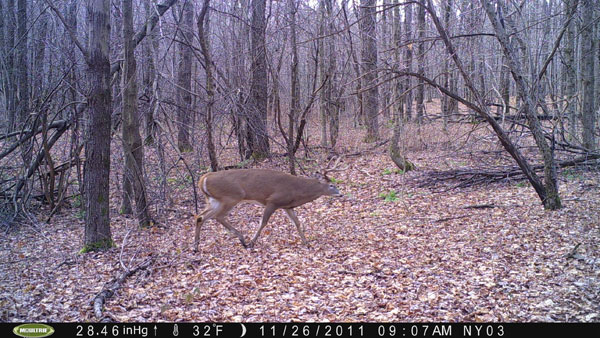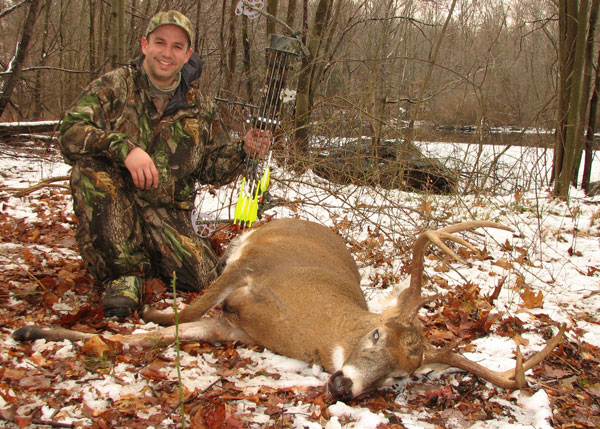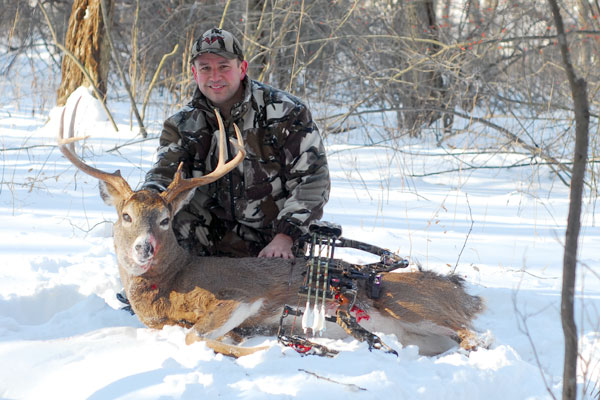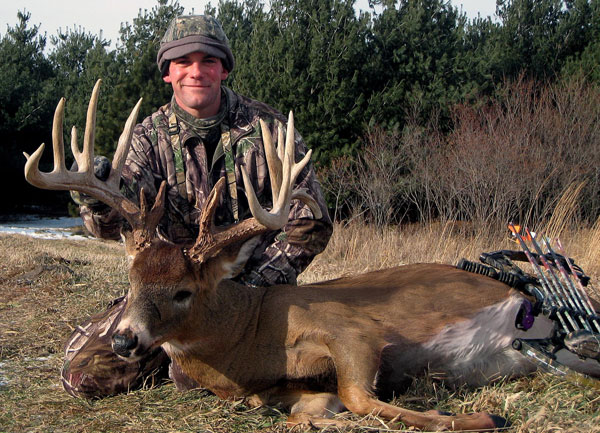It’s Thanksgiving
in November and those of us with tags are outside hunting during what’s left of the rut. Pre Rut
should be over, chasing is turning into lock-down and if you haven’t yet tagged
your buck you may be getting a little nervous.
Fear not. I
believe the best is yet to come.
Last year we
had two shooter bucks on one of my hunting properties. We saw one during the
pre-rut and would occasionally catch a night photo on our Moultrie M100 trail cameras.
When the peak rut rolled around, they all but vanished. Between the chasing
period and the dreaded ‘lock-down’ there was no consistent pattern and they
were nearly impossible to kill. The only thing you could hope for was being “lucky.”
 This was the buck we were after in 2011. A dandy 8 point that was 4.5 years old and would rarely show itself in daylight. He followed a group of does on 11/26 giving my son Matt a perfect 30 yard shot. The Moultrie camera is between us and the buck and captured the scene as we saw it that day.
This was the buck we were after in 2011. A dandy 8 point that was 4.5 years old and would rarely show itself in daylight. He followed a group of does on 11/26 giving my son Matt a perfect 30 yard shot. The Moultrie camera is between us and the buck and captured the scene as we saw it that day.
That stayed true until
the last week of November when things started to settle down. It was November 26,
2011 and the only morning I decided to leave my bow behind so I could
concentrate on filming my son Matt (who was 13 at the time). The buck we’d waited
for all year followed a group of does into our stand. He presented Matt with a
30 yard shot (which is at the far end of Matt’s practice range). As the buck
walked by our trail camera I whispered to Matt “shoot” but he still had not
drawn his bow! The buck presented both of us with several
incredible shot opportunities then eventually moved on . Matt was
upset at himself. He was too nervous to shoot this great buck at the far end of
his range so he passed. I was proud of him, but that’s the last time I’ll ever
leave my bow behind!
That was an important lesson for him, and a great reminder
for me. The rut is not always the best time to kill that trophy buck.
Bowhunting the
post rut is far different than the hunting the peak. When I look back at some
of the many DIY trophy bucks I’ve shot, the vast majority have been killed
during the post rut. It is my favorite time to hunt, by far!
I believe the post rut can be
broken down in phases and I’ve found different techniques work better than
others depending on which post-rut phase it's in. Here’s what I like to do
during these specific post-rut periods:
Peak + 5

During this
period the rut is not quite over yet. Some bucks may still be chasing while
others are in lock down. Generally things are starting to settle down a bit.
During this period I like to focus on the buck’s core area. Unless they’ve
been heavily pressured, the buck will generally gravitate toward his familiar
haunts. Especially those areas close to food sources.
 This Connecticut buck was killed on Thanksgiving day during an early snow storm. I knew he was around but had never seen him during the rut. He came back to a an oak ridge littered with acorns just five days after the peak.
This Connecticut buck was killed on Thanksgiving day during an early snow storm. I knew he was around but had never seen him during the rut. He came back to a an oak ridge littered with acorns just five days after the peak.
He still has sex on the
mind, no doubt, but he’s beginning to focus again on his other needs of
security, water, and food so that’s where I like to be positioned.
Peak +15

By now the
majority of does have been bred and mature bucks are nearly wore out. But
instead of reverting back to bachelors they act more like companions. Like the
buck that passed my son at 30 yards, he was simply following does around during
the last weekend of November. He gave us no indication that he was wound up.
He appeared tired and simply liked being with other deer. Prior to the rut
this buck was never seen in daylight - but here he was walking around at 9:00
AM. During this period I generally like to hunt the core area on trails
frequented by does. There’s a good chance he will follow them right past your
stand just as it happened last year.
Peak +30

Depending on
your area this is when the 2nd rut starts up. The does not
impregnated during November come back into heat and the buck gets wound up all
over again – although far less intense than during the November period. He
will seek out does, will begin to work scrapes again, and will start moving beyond
his range once more. During this period I stay in his core area however I like
to use mock scrapes again like I would during the pre-rut period.
 I hunted this 7.5 year old Connecticut buck for 3 years. He was incredibly difficult to kill and evaded hunters for years. But he made a mistake during mid December as he followed does to a food source.
I hunted this 7.5 year old Connecticut buck for 3 years. He was incredibly difficult to kill and evaded hunters for years. But he made a mistake during mid December as he followed does to a food source.
Peak +45 on

By this
period, the November and December rut is over and the buck’s entire focus is on
nourishment. For the late season after the 2nd rut and beyond I
focus entirely on food and cover. Late season food plots like brassicas,
standing cornfields, and preferred food sources like ridges that still have mast
on the ground would be my top choices. Where bait is legal, this can also be
the most effective time for a mature buck to visit bait stations however
natural food sources are far more effective for mature animals.
 This 216" buck was killed on New Years' Eve in Illinois. Despite significant hunting pressure and an abundance of trail cameras nobody had ever seen this buck until he walked in front of Matt Rehor. The buck was focused entirely on nourishment and was following does to a late season food plot.
This 216" buck was killed on New Years' Eve in Illinois. Despite significant hunting pressure and an abundance of trail cameras nobody had ever seen this buck until he walked in front of Matt Rehor. The buck was focused entirely on nourishment and was following does to a late season food plot.